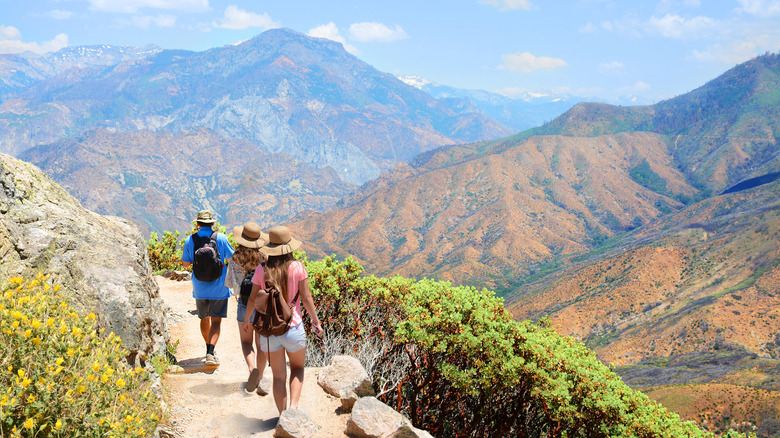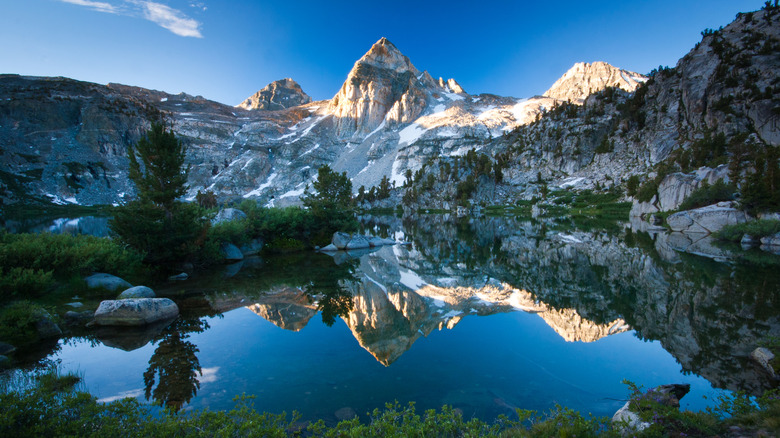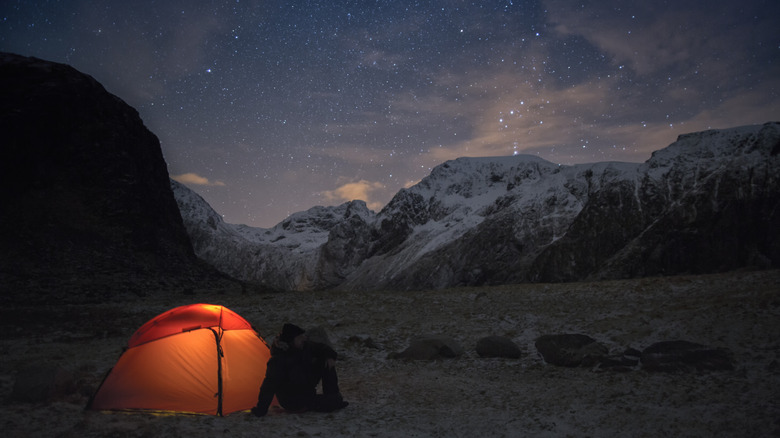These Glorious Lakes Can Only Be Reached By Hiking In California's Sequoia & Kings Canyon
When it comes to outdoor grandeur in California's Sierra Nevada mountains, Yosemite is arguably the star of the show. This is one of the most popular national parks in the U.S., and you can witness some magnificent views on scenic hikes throughout the protected area. A glimpse of its deep canyons and sheer rock rises are a sight to behold. However, just down the road are two other gems that see far fewer visitors: Sequoia & Kings Canyon — which, in addition to their high-mountain splendor — are also home to some of the tallest trees in the world.
While technically two separate national parks, Sequoia and Kings Canyon border each other and are usually visited together, so the National Park Service pretty much treats them as a single entity, which means you can access both with a single pass. And while many come to marvel at the massive trees — such as the legendary General Sherman — both parks offer spectacular opportunities for backpacking, with the Rae Lakes Loop as the arguable crown jewel.
This 41.1-mile circuit path can be done clockwise or counterclockwise, and usually takes five days to complete. The highlight is the alpine lakes the trail is named for — shimmering bodies of pristine water surrounded by mighty granite peaks. All the scenery along the way will take your breath away, which is why this trail is why the Rae Lakes Loop is regarded by some as one of California's best multi-day hikes.
Marvel at some of the Sierra Nevada's best scenery
You can start the Rae Lakes Trail from either the Wood's Creek trailhead (clockwise) or the Bubb's Creek trailhead (counter clockwise). Many people choose to hike the trail clockwise because of the more gradual elevation gain, while going counter clockwise gets the big climbs out of the way in the first two days, making it all downhill from there.
Whichever you choose, you're in for a challenging route, as the Rae Lakes Trail features a total elevation gain of 9,000 feet, making it punishing for even the most experienced hikers. However, for every step of pain you are rewarded with some of the most diverse spectacular scenery the high Sierra has on offer: idyllic valleys, wide meadows, waterfalls, mountain passes, and perfect lakes. These invigorating waters will clean off the sweat and grime and recharge your battery after a tough day of grinding it out on the trail.
You'll also likely to spot plenty of wildlife, including mule deer, marmots, raptors, and — if you're lucky — endangered bighorn sheep. While mountain lions call the region home, they're extremely reclusive, so you're unlikely to come across any. However, black bears are extremely active in the area, which means you are required to carry bear-resistant canisters for food storage.
Know the regulations before you head out on the Rae Lakes Loop
Because of the fragile alpine ecosystem, not to mention the loop's popularity, there are certain rules hikers are required to follow on the Rae Lakes Loop. Most of the campsites along the route are restricted to just one or two nights stay, so check up on the regulations when you go. Campfires are also prohibited above 10,000 feet, and pets along with any kind of wheeled vehicles are not allowed anywhere within either national park.
The Sierra Nevada also sees a lot of snow in the winter, which means certain spots — especially 11,978-foot Glen Pass (the highest point of the hike) — can be smothered in snow until late July, making it impassible to hikers. Also, there are several stream crossings that may be treacherous or even impossible in May or June when the runoff is high, so make sure to check with the rangers station with regard to conditions before you set.
Permits are required to hike the Rae Lakes Loop and can be tricky to get from May to late September, when a quota system is in effect. You can reserve your permit up to six months ahead of time, or try your luck with the daily allotment at recreation.gov. However, October can be a terrific time to hit the Rae Lakes Loop, since you'll need no permit and fewer people will be on the trail. That said, the weather can change quickly in the Sierra Nevada, including storms that bring sudden rain and even snowfall in the early autumn, so pack accordingly. For more hiking adventures in California, visit its biggest state park.


